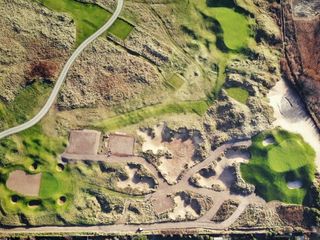What Effect Will The Lockdown Have On Golf Course Conditioning?
Three experts give us their thoughts on course management through the Coronavirus crisis and how playing surfaces are being affected.


Three experts give us their thoughts on course management through the Coronavirus crisis and how playing surfaces are being affected.
What Effect Will The Lockdown Have On Golf Course Conditioning?
This is a very strange time for all of us but, for golfers, one of the oddest thoughts is of deserted courses, still maintained but totally unused.
The R&A and BIGGA have released guidelines on best practice for essential maintenance of golf courses in this country and on how clubs should look to restructure working practices to follow government guidance for essential workers.
We spoke to three course managers from across the country – Craig Gilholm, Course Manager at Royal Liverpool GC, Rob Surgey Senior Course Manager of the Burhill Group and Richard Mullen, Course Manager at Banchory GC in Aberdeenshire - to get their thoughts on what effects the lockdown period is having and will have on their golf course maintenance and conditioning.
Craig Gilholm – Course Manager Royal Liverpool GC
It’s a double edge sword. We normally run a team of 12 men, and we’ve halved it. But with no golfers, there’s no pressure to keep ahead, allowing us to cut fairways over two or three days, cut the greens twice a week, cut the surrounds once a week.
Get the Golf Monthly Newsletter
Subscribe to the Golf Monthly newsletter to stay up to date with all the latest tour news, equipment news, reviews, head-to-heads and buyer’s guides from our team of experienced experts.
It’s a breath of fresh air actually, like going back to how I learned my trade at Muirfield back in 1990: cutting fairways once a fortnight! Modern culture means expectations have changed but it’s nice to revisit those days for this spell.
The last five weeks weather has been beautiful with only about six or seven mm of rain. Without traffic, it’s certainly the case that the grass is not as stressed as normal.

People might say no traffic will make the greens softer but in this short period of time, it’s not noticeable. I think if it went on for months then maybe things would change as you do want footfall. But we had a busy winter, right up to the lockdown. So, yes, it’s allowed for a recovery on areas that have suffered.
At this point in time, I’m delighted. We’re keeping up with regular maintenance programmes and I’m not losing sleep.
The Open moving back to a later date is not a problem. With three new greens laid last winter, 18,000m2 of new turf overall, it gives more time for that to bed in, so really it’s is a good thing for us from a greenkeeping perspective. Right now, the new turf is challenging for us with the dry weather. When we’re not cutting grass elsewhere on course, we’re looking after that turf.
Rob Surgey – Senior Course Manager Burhill Group
The lack of traffic on our courses has certainly had a beneficial impact on the greens. No new pitch marks mean we have a good full coverage of grass.
The lack of divots out of the fairways and tees has left us with a better sward. Actually, the first job we did when we went into lockdown was to repair as many divots as possible to aid recovery while our golfers were away from the courses. Hopefully these unique circumstances mean the courses will be well rested and recovered.
We’ve had to change the way we work to ensure we maintain social distancing and reduce contact on areas around the maintenance department. We all have our own set of keys for the machinery and have designated buggies assigned to each individual as examples.

The regulations have impacted on the way we work, but our team has done a great job making changes to their standard practice in the weeks of lockdown so far.
The weather has been challenging. After an extremely wet winter, we’ve had warmer conditions with virtually no rain since March. This has presented its own challenges with courses drying out.
The expectation from golfers will be that the courses should look like Augusta when they open, and we have to manage that expectation given the decrease in staff levels. However, once we are back to full staff capacity it shouldn’t take long to get the overall course presentation just where we want it.
Richard Mullen – Course Manager Banchory GC
Lockdown “essential maintenance” could be looked at in a number of ways, so it was a welcome relief when the governing bodies and the government specified what we were allowed to do.
At Banchory in a typical week would see 205 working hours. In an equivalent lockdown week this year, we are running skeleton staff and completing just 45 hours.

We have cut the greens at a higher level to protect the plant, and no more than three times in seven days. We’ve also cut tees and aprons higher and less frequently, and fairways and rough only once a week. We haven’t been able to maintain hazards, which will of course have an effect.
Yes, we haven’t had holes to change, bins to empty and the courses will not have divots or pitch-marks (Hallelujah!). But, with less mowing, spraying, reduced dressings and reduced inputs of nitrogen and water, the standard of the surface will change. I won’t say drop, as reducing synthetic fertilisers and water input isn’t a bad thing.
Maybe this challenging situation will show some in the turf industry that the plant can actually perform with less input? But, it’s difficult to assess that as we don’t have the 125 pairs of compacting feet, plus mowers and rollers per day to make an accurate comparison.
Just maybe, though, it will give us more confidence to take a more sustainable approach in the future… Only time will tell.
Don't forget to follow Golf Monthly on Facebook, Twitter and Instagram for more golf news.

Fergus is Golf Monthly's resident expert on the history of the game and has written extensively on that subject. He is a golf obsessive and 1-handicapper. Growing up in the North East of Scotland, golf runs through his veins and his passion for the sport was bolstered during his time at St Andrews university studying history. He went on to earn a post graduate diploma from the London School of Journalism. Fergus has worked for Golf Monthly since 2004 and has written two books on the game; "Great Golf Debates" together with Jezz Ellwood of Golf Monthly and the history section of "The Ultimate Golf Book" together with Neil Tappin , also of Golf Monthly.
Fergus once shanked a ball from just over Granny Clark's Wynd on the 18th of the Old Course that struck the St Andrews Golf Club and rebounded into the Valley of Sin, from where he saved par. Who says there's no golfing god?
-
 Verne Lundquist Lifts Lid On Emotional Masters Farewell With Tiger Woods
Verne Lundquist Lifts Lid On Emotional Masters Farewell With Tiger WoodsTiger Woods shared a poignant moment with the legendary broadcaster beside the 16th green in the final round at Augusta
By Ben Fleming Published
-
 John Catlin Wins Back-To-Back Asian Tour Titles Whilst LIV Golfer Likely To Remain Outside World's Top 100 Despite Strong Showing
John Catlin Wins Back-To-Back Asian Tour Titles Whilst LIV Golfer Likely To Remain Outside World's Top 100 Despite Strong ShowingThe American cruised to the Saudi Open title by seven shots, while David Puig is likely to stay outside the world's top 100 despite finishing fifth
By Matt Cradock Published
-
 Is This FootJoy's Most Exciting New Golf Shoe In Years?
Is This FootJoy's Most Exciting New Golf Shoe In Years?Dan Parker discusses whether the new FootJoy Fuel golf shoe has the potential to be FootJoy's most exciting to date...
By Dan Parker Published
-
 Governing Bodies Crack Down On Distance As Driver Shaft Lengths Limited
Governing Bodies Crack Down On Distance As Driver Shaft Lengths LimitedThe R&A and USGA have introduced a new local rule to ensure professionals and elite amateurs do not use 48-inch driver shafts
By Elliott Heath Published
-
 Five-Year-Old Prodigy Raising Money And Awareness For Organ Donation
Five-Year-Old Prodigy Raising Money And Awareness For Organ DonationGeorge is taking on the challenge to raise money and awareness for organ donation
By Andrew Wright Published
-
 Robert MacIntyre Returns To Shinty After Ryder Cup Disappointment
Robert MacIntyre Returns To Shinty After Ryder Cup DisappointmentThe left-hander has been in action for his local shinty side, Oban Celtic
By Andrew Wright Published
-
 Pro Plays 36 Holes In Under 80 Minutes To Win British Speedgolf Championship
Pro Plays 36 Holes In Under 80 Minutes To Win British Speedgolf ChampionshipBuckinghamshire professional Luke Willett took the British Speedgolf title
By Fergus Bisset Published
-
 "A Real Kick In The Teeth" - Greenkeeper After "Embarrassment" Course Comments
"A Real Kick In The Teeth" - Greenkeeper After "Embarrassment" Course CommentsWe chat to James Tibbles, head greenkeeper at Andover GC, after he was subject to negative comments on the course's condition
By Elliott Heath Published
-
 Tiger Woods' 2002 Backup Putter Sells For $393,300
Tiger Woods' 2002 Backup Putter Sells For $393,300Tiger Woods' 2002 Backup Putter Sells For $393,300
By Matt Cradock Published
-
 Olivia Lee Wins 2021 Peter McEvoy Trophy
Olivia Lee Wins 2021 Peter McEvoy TrophyOlivia Lee has become the first female to win the historic Peter McEvoy Trophy.
By Dan Parker Published